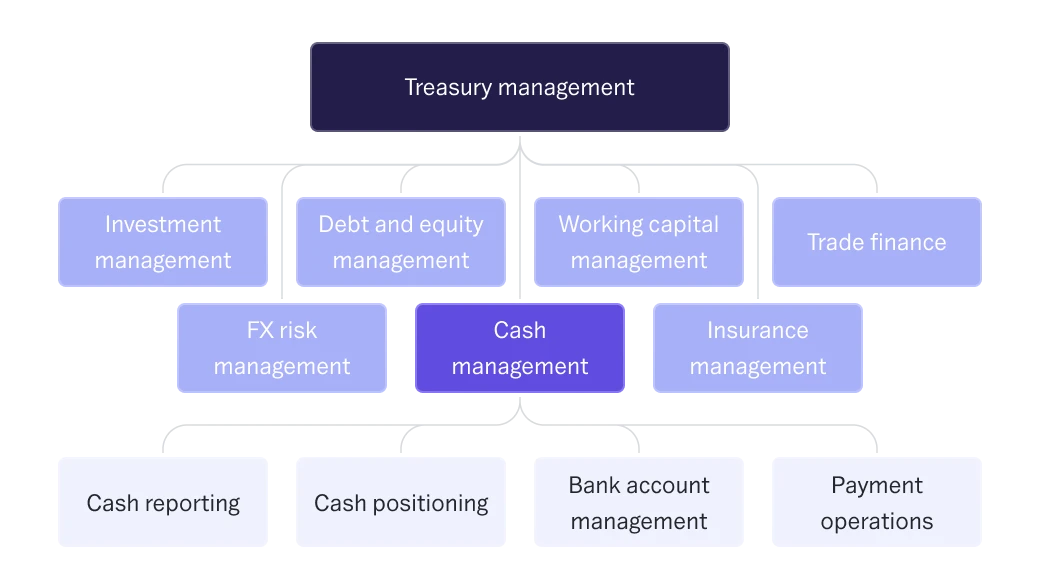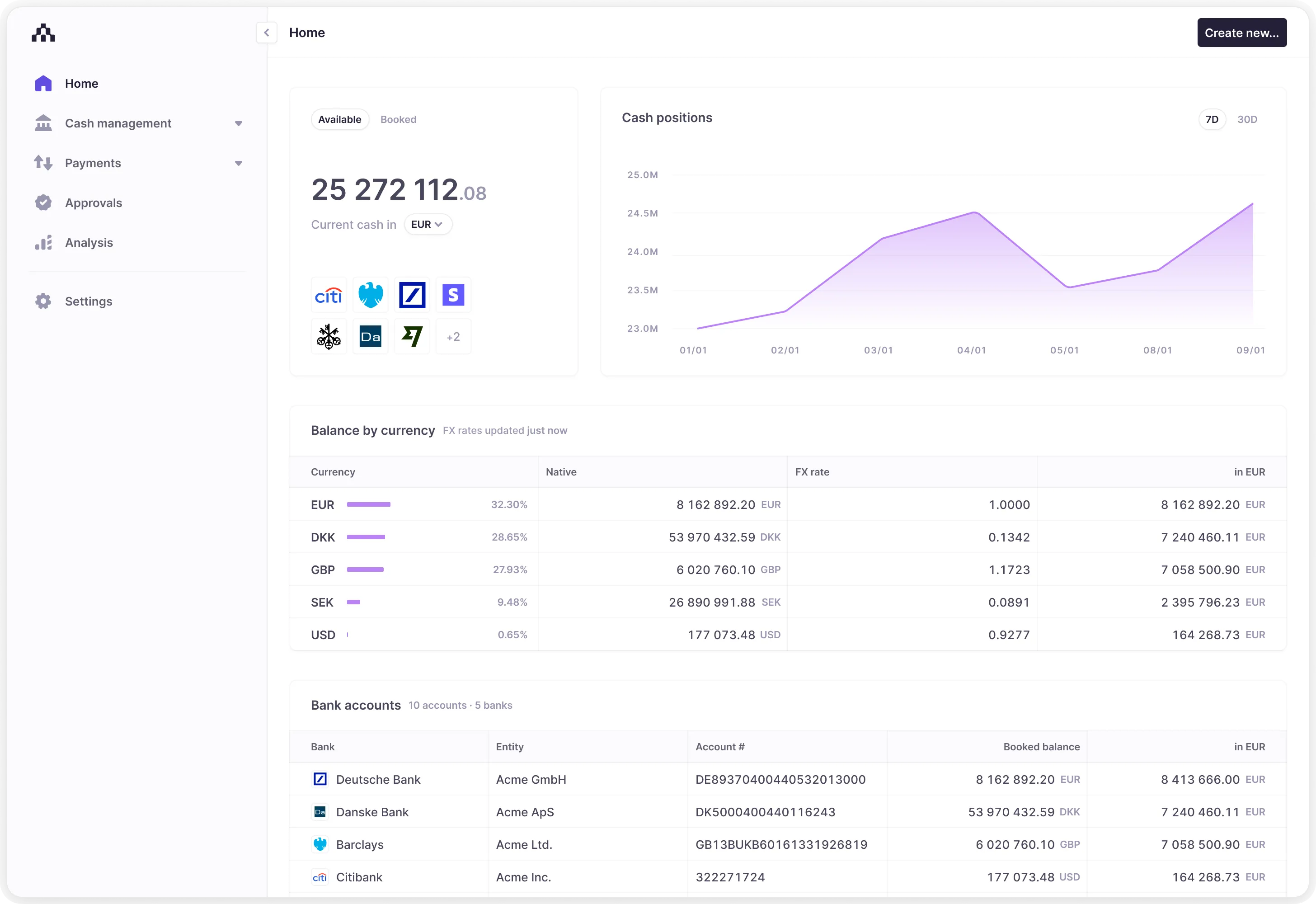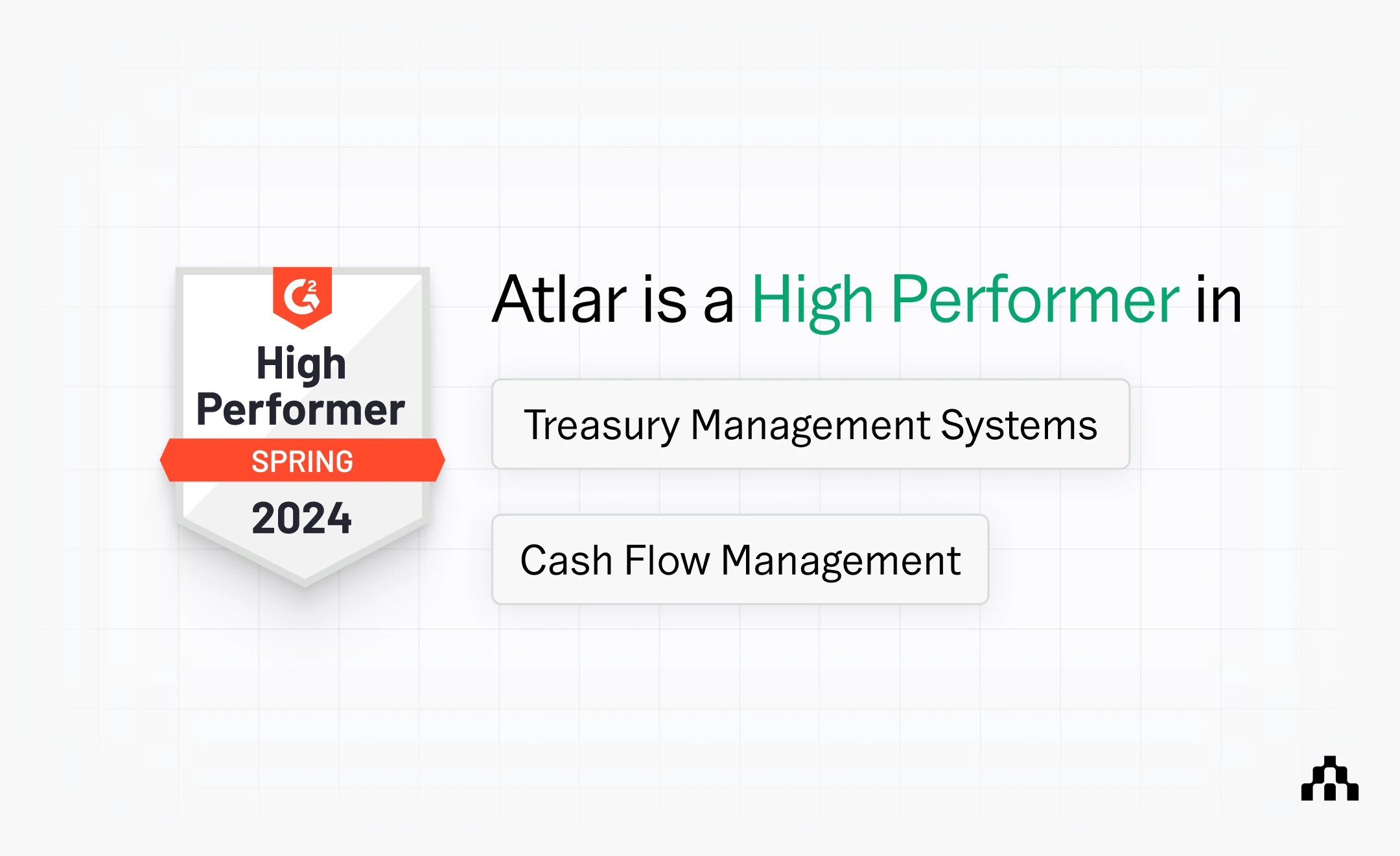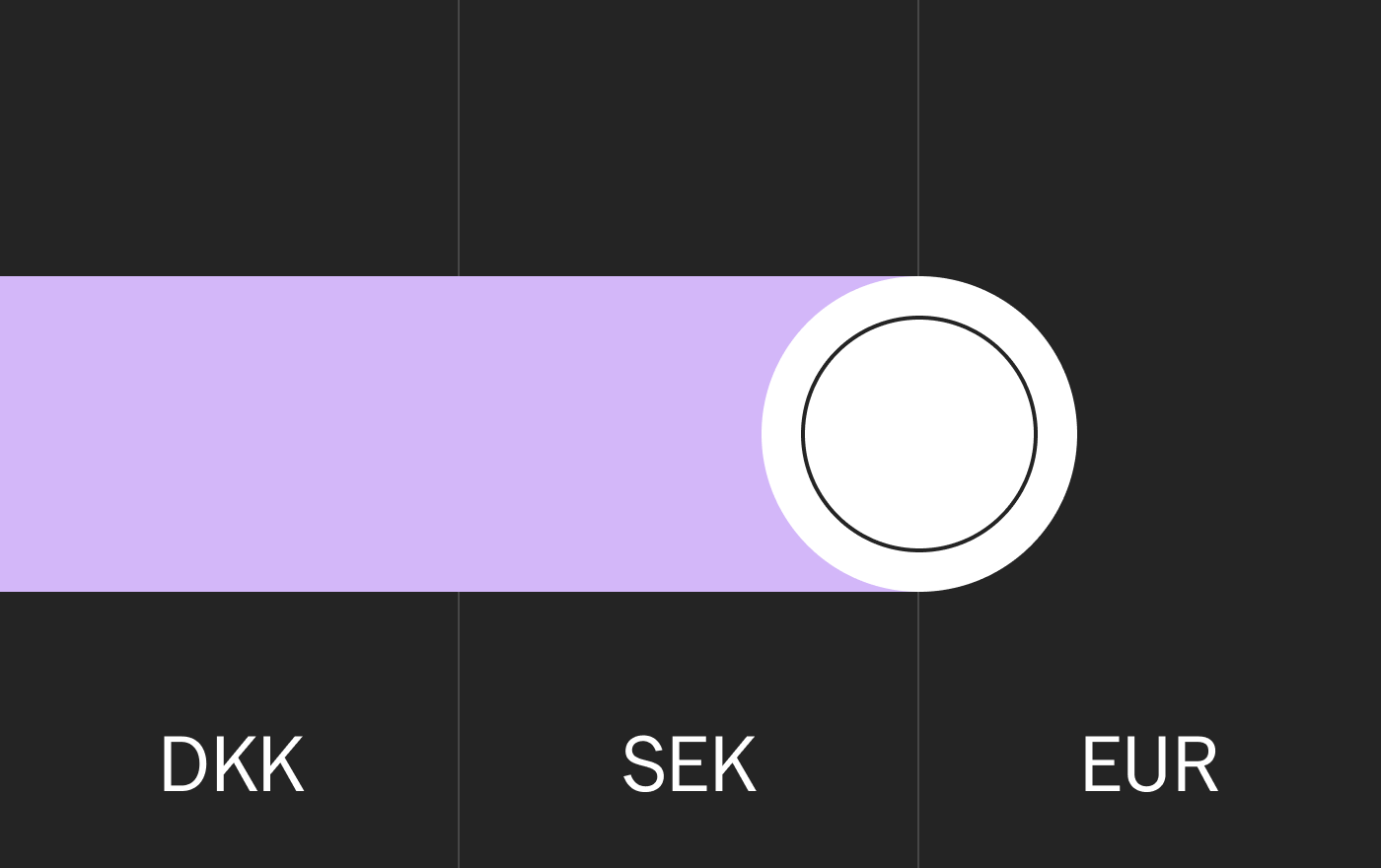
What is cash positioning and how do you do it?
Whether you're keeping a smaller business afloat or steering a large enterprise’s finances, cash positioning is one of the most fundamental treasury management tasks you’ll perform.
Cash positioning tells you a company’s financial state at a specific moment in time. It refers to the process of figuring out how much money the company has, where it’s located, and whether it’s readily accessible. This then lets you determine if there’s enough to cover upcoming payments and expenses, and if there’s any spare money left over.
Cash positioning is not as simple as checking a bank balance. When we say ‘money’ what we really mean is liquidity, which includes cash balances held in a bank account but also other types of liquid assets that can be converted to cash at short notice (known as cash equivalents).
This is what makes cash positioning so important for businesses of all sizes: it provides a fuller understanding of a company’s short-term finances beyond just its bank balance. As a process it can also become significantly more complex as a business grows, particularly when performed manually.
Cash positioning is a core sub-function of cash management. Establishing an accurate cash position is a basic prerequisite for most other cash activities: managing incoming and outgoing payments, forecasting future cash flow, and potentially investing excess cash on a short-term basis. For more background on how it relates to other treasury management activities, read our guide on cash management versus treasury management.

What is cash positioning?
Cash positioning is the process of understanding a company's current liquidity position. The aim is to determine the financial state of a business and the immediate availability of funds to cover any short-term financial obligations. It helps you answer questions like, “if your business had to pay for a large expense unexpectedly, how much could it afford?” and, beyond that, “does your business have any excess cash that could be put to use?”
We do this all the time as individuals: checking your bank balance to see if there’s a financial cushion for any unforeseen circumstances, or if any spare money can be set aside for a bigger purchase or investing. The difference is that, to understand a company’s finances, you need to account for more types of assets than cash balances alone and businesses have a much greater variety of cash inflows and outflows.
Let’s look at a simple example of cash positioning in practice. A business has cash or cash equivalents being held in one or more bank accounts that, at the beginning of the month, amounts to $10,000. Over the course of the month, money comes into the business in the form of sales, investments, or financing and money leaves the business to cover salaries and other operational costs, debts, or liabilities. The total cash inflow is $5,000 and the total cash outflow is $4000, which means the company’s total cash flow is $1000. At the end of the month, the company’s new cash position is $11,000.
This sounds simple enough, but gathering the relevant data manually can be challenging. Consider a company with multiple bank accounts in different countries, holding funds in different currencies, spread out over multiple business entities, each with various inflows and outflows. You may also have to source financial data from other places like payment platforms, ERP systems, and expense management tools.
Where this becomes even more complex is when you broaden the scope from a company’s cash balances to its overall liquidity position, including more types of liquid assets, expected inflows and outflows, and pending transactions.
Cash positioning, at least when done manually, is the act of gathering, analyzing, and verifying all of this cash flow data in order to arrive at a company’s current cash position.
Cash positioning versus cash flow forecasting
In a sense, cash positioning and cash flow forecasting are two sides of the same coin. Both are important to understanding a company’s short-term financial situation. The difference is that a forecast seeks to predict how much cash a company will have in the future, while cash positioning is backward-looking.
Cash positioning involves compiling historical cash flow data over a period of time in order to understand a company’s cash position in the present. This cash position then provides the starting point from which you can forecast the effect that future cash inflows and outflows will have on a company’s finances.

What is a cash position?
A cash position is the amount of liquid assets (cash and cash equivalents) that a company has at its disposal. It is a key business metric and is commonly used in relation to a company’s liabilities, or the short-term financial obligations it needs to pay.
Comparing your cash position to your liabilities is the logical next step because this tells you how much cash your business has left over once things like loan repayments, money owed to suppliers (accounts receivable), and other expenses are accounted for. This is what gives you the clearest picture of your company’s current finances and where your money should be allocated in the short term.
Assets and liabilities
A company’s cash position includes the balances it holds in its bank accounts as well as any physical money (coins and banknotes), but also other highly liquid assets that can be readily converted to cash. Referred to as cash equivalents, these assets include money owed by customers (accounts receivable) and any investments such as treasury bills and money market funds.
Current assets to include:
- Cash balances in bank accounts
- Physical cash (if applicable)
- Cash in savings accounts and certificates of deposit
- Accounts receivable
- Short-term financial instruments (treasury bills, money market funds, marketable securities)
When incorporating liabilities in a company’s cash position, the focus is on the most immediate financial obligations with a relatively short time horizon. These include upcoming salary payments, money owed to suppliers (accounts payable), any credit card repayments or credit lines, the portion of long-term debt that needs to be paid off in the short term, and any expenses accrued that have not been invoiced.
Current liabilities to include:
- Salaries payable
- Accounts payable
- Credit card debt and other short-term credit lines
- The portion of long-term debt expected to be repaid
- Accrued expenses
Cash position versus cash flow
Though closely related, a company’s cash position is not the same as its cash flow. Cash position refers to the amount of money you have right now, while cash flow refers to inflows and outflows of money over a specific period of time. In other words, your cash flow determines your cash position – and both are useful ways of measuring a company’s financial health.
Cash position versus cash balance
The term cash balance is often used interchangeably with cash position, but in reality has a narrower definition. Cash balance refers to the actual balance available in bank accounts and any physical cash held in cash registers or similar locations. In other words, it represents the tangible amount of cash that a company has on hand. Cash position refers to a company’s overall liquidity and takes into account other liquid assets, expected inflows and outflows, and pending transactions.
Liquidity ratios
You may also see a company’s cash position represented as a ratio, such as the ‘current’ or ‘quick’ ratio. These ratios are designed to illustrate your cash position by dividing your current assets – including cash and cash equivalents – by your current liabilities. There are two main types, the current and quick ratio, that differ in terms of which assets are included.
Current ratio
The current ratio, also known as the working capital ratio, is calculated by dividing your current assets by your current liabilities. It takes into account all assets that can be made liquid within one year, taking a longer term view of liquidity compared to the quick ratio. It measures your business’s ability to meet its liabilities when they come due.
How it’s calculated: Current Assets (Cash + Cash Equivalents + Accounts Receivable + Inventory) / Current Liabilities
Quick ratio
The quick ratio, or acid-test ratio, tells you if your company has enough money on hand to pay your bills and staff. It includes all assets that can be made liquid within ninety days, therefore excluding inventory, and excludes long-term debts from your current liabilities. Although not widely used by financial institutions, the quick ratio can be useful in understanding whether a company can afford a large, sudden expenditure.
How it’s calculated: Current Assets (Cash + Cash Equivalents + Accounts Receivable) / Current Liabilities
Why is cash positioning important?
Cash positioning is critical in terms of what it tells you about a company’s financial state and as a practical enabler of other cash management activities. A strong cash position means that a company is able to cover its current financial obligations with cash – when a company has a large cash position above and beyond these obligations, it is a clear signal of financial health.
More practically, cash positioning enables the treasury function to make decisions and take actions based on the company’s cash position. It lets you improve working capital, reduce financial risk, capitalize on growth and investment opportunities, forecast the future financial state of the business, and make longer term plans to optimize the company’s liquidity. Below are all the ways that accurate cash positioning benefits a company.
Enabling efficient cash management
Growing companies, or those with unpredictable cash flow, can occasionally struggle to meet their financial obligations, harming the company’s daily operations. Cash positioning requires you to regularly review inflows and outflows and their impact on the company’s short-term financial health, ensuring that the business can cover its upcoming expenses, debts, and liabilities.
Paying suppliers on time
Inaccurate cash positioning can result in cash flow shortages, forcing companies to delay or miss payments. Effective cash positioning allows companies to optimize their payment operations and allocate funds to accounts payable as efficiently as possible, avoiding any penalties and relationship damage.
Capitalizing on growth opportunities
Cash positioning helps you identify surplus cash and put it to better use, as opposed to it languishing in a low-interest bank account. This might mean moving excess cash to a higher-yield savings account or investing it in bonds and money market funds. Alternatively, the cash can be reinvested in the business to seize growth opportunities, such as by increasing hiring or putting it towards a strategic acquisition.
Reducing financial risk
Maintaining an accurate, up-to-date cash position is essential in managing financial risk efficiently. It lets you confidently keep sufficient cash in reserve to mitigate the potential risks of economic downturns, unexpected expenses, market volatility, and any other unforeseen circumstances.
Signaling financial health
A strong, accurate cash position is a clear signal of financial health for external stakeholders. Excess cash can be reinvested in the business, returned to shareholders as dividends, or put to use in other ways. Conversely, a weak cash position raises concerns about the company’s ability to meet its upcoming financial obligations and longer term future. This makes it a key metric for outsiders: investors assess a business’s cash position before buying stocks, and banks do the same before providing loans.
How to calculate your cash position
How you actually calculate and track your cash position in practice depends largely on the tooling available to you. Cash positioning has traditionally been performed manually at specific intervals, such as at the end of the day or month, using a company’s cash flow statement and bank statements. Nowadays, technology solutions can automate some or all of this process, providing cash position reports that are updated continually and can be accessed at any time.
Traditional (manual) cash positioning
Calculating a cash position manually involves subtracting the money going out of a business (cash outflows) from the money coming in (cash inflows) for the period of time that has elapsed since the company calculated its cash position most recently. Here’s the process step-by-step:
- Retrieve the most recent cash position from the cash flow statement, a financial document that is usually prepared on an annual basis to provide a snapshot of the company’s cash reserves.
- Review the previous cash position and consider any additional inflows and outflows that have occurred during the intervening period and should therefore be included in order to account for the elapsed time.
- Locate bank statements for the corresponding period and reconcile them with the company’s ledger to verify their accuracy.
- Analyze inflows and outflows by reviewing bank statements, sales income, operational expenditures, loan repayments, investments, and any other cash-related activities.
- Calculate the current cash position by adding total inflows to and deducting total outflows from the prior cash balance.
In order to manage cash effectively, treasury teams often aim to track their company’s cash position on a daily or weekly basis. Doing so manually involves compiling large amounts of data, which comes with the following challenges:
- Manually reconciling bank statements, categorizing transactions, and calculating cash flows can be extremely time-consuming. This can lead to delays in determining the cash position, by which time it may already be outdated.
- Having to record and categorize transactions manually increases the likelihood of data entry errors, formatting errors, and incorrect calculations that affect cash positioning accuracy.
- Calculating your cash position manually means it will be measured at fixed intervals only, such as at the end of the week or month, instead of on a continuous basis.
- Spreadsheets based on outdated information lack real-time visibility of your cash position. This makes it harder to spot current trends and identify potential cash flow issues in advance.
- Manually aggregating transactions across various currencies, bank accounts, and business entities can slow down processing even further, preventing teams from making timely decisions.
Needless to say, manual cash positioning is a time-intensive task that can easily consume several hours for multiple team members: logging into online banking portals, downloading files for each bank account and currency, aggregating the data in a spreadsheet, and updating calculations. Ultimately this means less time spent on generating insights, making decisions, and managing cash proactively.
Automated cash positioning
Modern treasury platforms like Atlar offer cash management tooling that automates manual cash positioning tasks, enabling treasury teams to focus on initiatives that actually improve a company’s cash position, rather than simply calculating it. Below are a few ways in which automating cash positioning helps to improve accuracy and efficiency.
Seamless data integration
With automated cash positioning, all inflows and outflows across various bank accounts, currencies, and business entities are automatically recorded as they happen and centralized in one platform. Atlar supports multiple connectivity channels including host-to-host, Swift, and API – enabling businesses to consolidate financial data from payment platforms and other finance tools as well as bank accounts.
Real-time cash positioning
Automation allows you to update your cash position on a continuous, ad hoc basis as opposed to it being a snapshot in time. This lets treasury teams make decisions faster using more accurate data, potentially unlocking ways to put cash to better use on a short-term basis. Unlike traditional platforms that process data every 24 or 48 hours, the Atlar platform can process data continuously in real time – letting teams access up-to-date cash position reports on demand.
Accurate cash reconciliation
Automated cash positioning eliminates the need to transfer bank statements and payment files from one system to another, or manually reconcile transactions with bank statements in a spreadsheet. With native integrations to ERP systems such as NetSuite and Microsoft Dynamics 365, Atlar enables continuous, cross-system data syncing and automated bank reconciliation.
Robust analytics and reporting
Spreadsheet-based cash position reports require a fair amount of data manipulation to maintain and offer limited flexibility, hindering your ability to identify patterns and trends over time. Atlar’s cash management solution lets you create historical cash flow reports in seconds, for any time horizon, and quickly filter on a specific bank, account, currency or entity. Reports that you access on a frequent basis can be saved and set to update dynamically over time, enabling teams to generate insights quickly instead of wrangling data.


How Atlar can help
Automated cash positioning allows finance and treasury teams to focus less on gathering data and more on analyzing it. This is particularly important as companies grow and their financial operations become more complex with inflows and outflows spread out across multiple systems, banks, and business entities.
Manually logging into online bank portals and creating bespoke reports in spreadsheets is simply inefficient as a company scales. Not only is it time-consuming, it’s impossible to generate cash insights in real time – limiting a company’s cash management strategies. Manual processes also inevitably succumb to date entry errors at some point, leading to unreliable reporting, inaccurate forecasts, and ultimately a lower level of confidence in the company’s cash position.
The Treasury Management System (TMS) led the way in automating data collection and cash positioning for over three decades. Today, these legacy solutions have become too costly to implement and maintain for all but the largest enterprise companies. Their outdated interfaces can be unintuitive to use, often requiring specialist help or dedicated training, and include features that are unnecessary for most teams.
Atlar provides customers like Acne Studios, GetYourGuide, and Forto with a single platform that consolidates all cash positions globally with user-friendly reporting and analysis tools. Unlike a legacy TMS, Atlar supports real-time connectivity out-of-the box and lets you get up and running in weeks. This way, treasury teams can reap the benefits of automation without all the overhead of a lengthy implementation and specialist consultants – and can start putting cash to better use that much sooner.
Want to see Atlar’s cash positioning tools in action? Book a demo with our team today.
Get started
See a demo
Discover the Atlar platform for yourself. Enter your email to get started.



























